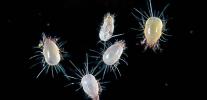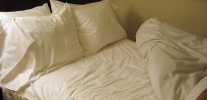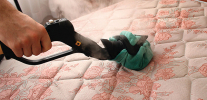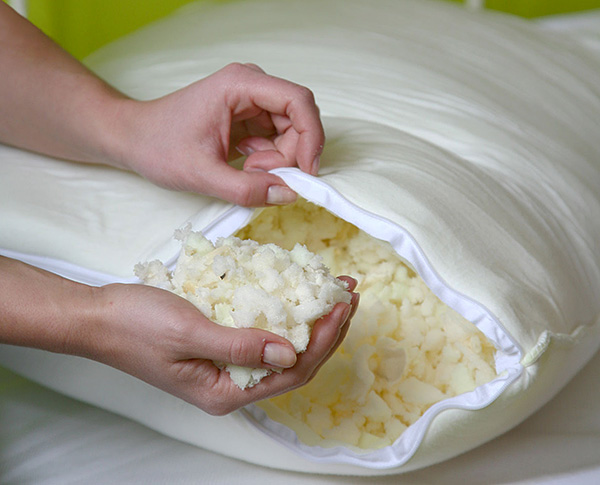
Dust mites that settle in pillows are one of the most common causes of home allergies, chronic rhinitis, and bronchial asthma. The reason is simple: these arthropods actively secrete allergens (experts consider them to be among the strongest in apartments and houses), and due to the fact that they are very close to a sleeping person, he inhales these allergens constantly, for a long time and in large quantities. As a result, the risk of sensitization to the discharge of dermatophagus mites is very high, and diseases caused by tick allergies are among the most common in the world.
It should be borne in mind that dust mites in one or another quantity live in virtually every residential area (worldwide). They are cosmopolitan and rather unpretentious to the living conditions.If a person can live normally indoors, then ticks can live and multiply here. To a large extent, their number depends on the sanitary condition of housing, but they are found even in clean and regularly cleaned apartments and houses.
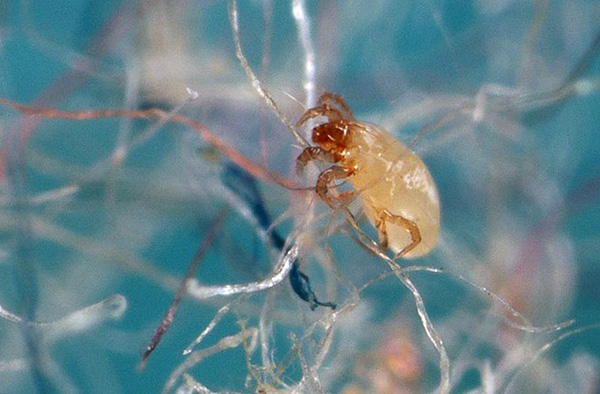
Moreover, if such mites started in the room and settled here mainly in places of dust accumulation under the furniture or behind it, then getting rid of most of them will be a matter of several thorough cleanings. However, if they multiply massively inside pillows or mattresses on the bed, then it will be much more difficult to remove them.
On a note
Some experts even tend to believe that infected pillows are easier to throw out and replace with new ones, rather than trying to clean them of ticks and highly allergenic products of their vital activity.
Simply put, the presence of dermatophagous mites in pillows is a serious threat to human health. If people living in the room have symptoms of diseases caused by these creatures, and there are other reasons to assume the presence of dust mites (for example, according to the results of special tests, which will be discussed below), then emergency measures should be taken to disacarise the home.
How to understand that such "pillow" mites are present in the bed, and what to do to destroy them? Let's understand ...
What ticks can settle in pillows
Today, it is reliably known that several types of dust mites settle in the pillows - the very ones that actively reproduce in any other places in the living room, where dust accumulates with the remnants of human skin.
Among these species, the most common are Dermatophagoides farinae (American dust mite) and Dermatophagoides pteronyssinus (European dust mite). Slightly less often, and in the housing of a person in general, and in pillows in particular, other dust mites settle: Tyrophagus putrescentiae, Glycyphagus domesticus. Specifically, "cushion" they are called only colloquially due to the frequent detection of them in the pillow filler. In general, they are not tied to pillows or to beds, and in the largest quantities are found simply in places with large accumulations of dust.
For example, the photo below shows individuals of Dermatophagoides pteronyssinus under a microscope:
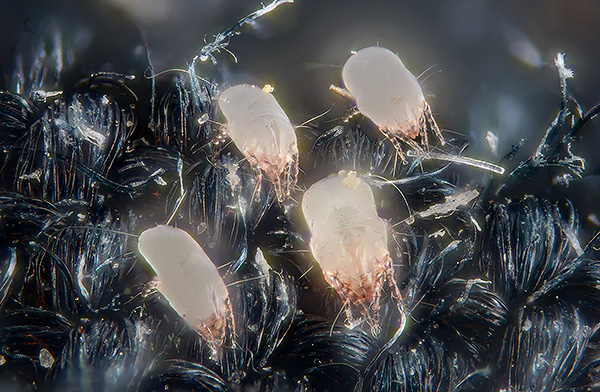
On a note
It is believed that representatives of the group of so-called granary ticks - the flour mite Caloglyphus rodionovi, the cheese mite Acarus siro and some others can also settle in the pillows.They are often found in all those places in the house, where typical dust mites are also detected, but they often settle right in the hair of domestic animals (they do not bite, but feed on particles of cornified skin). If the pet regularly jumps on the bed, then the risk of infecting pillows with barn mites is quite high.
It is interesting in this case that typical feather mites, parasitic in the plumage of birds, do not live in pillows. This is due to the fact that the most common parasites of feathers - full mites - can only live in the plumage of a living bird, because they feed not on the structural components of the feathers, but on liquid, which is excreted in the center of the feather when piercing the wall of the sap itself.
This process takes place only when a feather is pierced on a live bird, and in a separated feather (including fluff in pillows), no liquid is expelled when piercing. Consequently, the widespread parasites of bird plumage (especially the tick Syringophilus bipectinatus, which infects chickens and ducks on farms) cannot live in downy pillows.
In addition, all the fluff before the manufacture of pillows undergoes a special sanitization, including, in particular, disinsection and deacarization. That is, even if there are ticks in the fresh fluff, they will die during such processing.For this reason, in the fluff in the pillows can not be not only mites, but also various insect parasites.
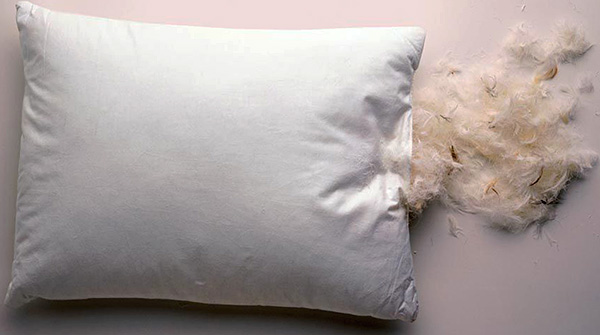
Thus, mites start up only in ready-made pillows. And it happens almost always in the living room in which the pillow is located. In the store or at work, infecting them is extremely unlikely.
Lifestyle dermatophagoid in bedding
Dust mites are permanent inhabitants of residential premises. Here they feed on exfoliating particles of skin that are peeling off from people and domestic animals.
Thus, each person loses up to 2 kg of skin in the form of dandruff and keratinized epidermis per year, which is separated in the form of small scales for natural reasons when the upper layers of the dermis are renewed. This amount is enough for constant feeding of about 2 million dust mites - they are microscopically small and are quite satisfied with this amount of food.

It is interesting
Often, dust mites constantly live in the hair of domestic animals, not going down on the floor or on the bed. From an evolutionary point of view, such populations are the beginning of the transition of dust mites to permanent parasitism.There is an opinion that this is how scabies itchs once became parasites. Their ancestors could pick up the skin in the nests of animals, then some individuals learned to live in wool and not leave it, only occasionally moving from one animal to another in close contact, and then completely adapted to life in the upper layers of the skin.
The greatest amount of crumbling skin is concentrated on the bed and bedding. Here, on a bed, a person spends a large amount of time, but often there are no additional barriers in the form of clothes between his body and the bed itself. At the same time, the skin particles that are not just settled on the surface of bedding, but trapped through the pores in the fabric inside the same pillows or mattresses, are almost impossible to remove from here.
As a result - if in the whole apartment, with regular cleaning, dust and such mite food can be cleaned regularly, then in the pillows all this is not just preserved, but constantly accumulates.

In addition, pillows may sometimes contain other food for dust mites - mold fungi and their spores.According to research, in the average pillow, which is used for more than 1.5 years, is more than 1 million fungal spores (primarily species of the genus Aspergillus). These fungi are not the main food for ticks, but in some cases significantly complement their diet.
On a note
It is noteworthy that pillows with synthetic filler are also often infected with mites, as well as down ones. At the same time, the fluff itself is not necessary for the mites, but they feed on the skin that falls here and sometimes the fungi breeding here. Dermatophage mites do not care where a person's skin is - among the fibers of a synthetic winterizer or holofiber, or among goose down. In addition, according to checks, in synthetic pillows the number of detected spores of mushrooms turned out to be on average higher than in downy ones.
In fact, for dust mites, pillows are “bags” of food. It would be strange if they did not multiply here in large quantities.
And they multiply ... Each tick lives about 50-70 days. Life expectancy of females is somewhat longer than that of males. After hatching from a nymph egg, ticks actively feed, molt several times and turn into an adult (mature stage) in 15-20 days. The females then mate with the males and every day they begin to lay 2-3 eggs.
During their sexually mature life, each female lays about 60-100 eggs, of which nymphs hatch after several days and repeat the same life cycle. Thus, in suitable conditions (literally greenhouses) in the absence of natural enemies, dust mites can increase their numbers by a factor of 20–40 over 3-4 weeks.
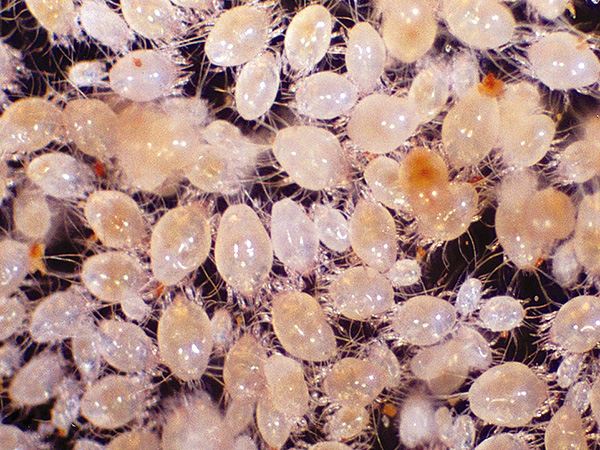
Fortunately, in fact, even in pillows, the rate of reproduction of dermatophagous mites is lower. Various factors affect: from diseases (for ticks, they also exist) to hunger due to the achievement of the maximum population size in terms of a specific amount of food. Nevertheless, their reproduction still proceeds very quickly: a few months after individual individuals hit the pillow, its entire filler can literally be teeming with ticks.
At the same time, a relatively small number of individuals in a room is sufficient for sensitizing a person and developing his allergy to dust mites. It is believed that a critical amount, above which there is a risk of developing tick-borne allergy, is 100 instances of ticks in 1 gram of pillow filler. Studies show that if the mites have penetrated into the pillow, this number appears already after 6-8 months.
In fact, in every pillow where these pests appear, they multiply to dangerous quantities, since there are often no hard limiting factors. So, almost every pillow is a potential source of allergens.
Harmfulness of dust mites
The presence of dust mites in the bed is very dangerous due to the high sensitivity of people to mite allergens. This is due to the significant biochemical activity of these allergens: the main ones are digestive enzymes, due to which the tick can digest its specific food (dry fragments of human skin).
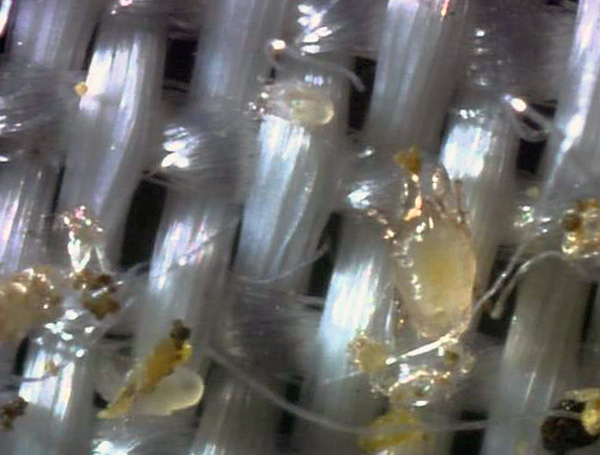
Some of these enzymes are excreted by the mite. If in the future a person inhales them, the allergens will settle on the surface of the mucous membrane of the respiratory tract. Having a protein nature, they are likely to be recognized by the immune system as foreign substances (antigens), and a specific immune response will be developed for them. Even with some probability this response will be excessive, and then with repeated ingress of the allergen into the body will develop an allergy.
Similarly, allergy develops when tick excreta get into the skin or into the digestive tract.
Somewhat less frequently, hypersensitivity develops not on digestive enzymes, but on particles of the cuticles of dead or faded ticks.
On a note
Often, allergies also develop into the various components of the molds present inside the pillows. At home, it is very rare to find out which allergen — tick-borne or fungal — is allergic to a person.
Due to the small particle size, all allergens from the pillow easily pass through the pores into the napernik tissue, settle on the face and get into the air inhaled by humans. In fact, a person sleeping on an infected pillow is constantly in a cloud of dried mite excrement and fragments of chitinous membranes of these arthropods.

Due to the high aggressiveness of tick-borne allergens and due to constant long-term contact with them during sleep, allergies often develop into chronic rhinitis, atopic dermatitis and bronchial asthma. According to statistics, it is dust mites - the most common cause of asthma in the world.
Such diseases caused by dust mites are dangerous in the first place because they become almost lifelong for many people.Even if a person can completely get rid of ticks in his own housing, then he should then get into any room, in the dust of which the corresponding allergens will be present - and the allergy will repeat. Moreover, this will happen even if the number of ticks is relatively small, incapable of leading to primary sensitization - the organism of an allergic will still pathologically react.

Consequently, the quality of life of a person with tick-borne allergies deteriorates significantly. At a minimum, the pathology is manifested by quite severe symptoms:
- Nasal congestion during sleep (sometimes complete);
- Acute allergic rhinitis or rhinoconjunctivitis with a characteristic clinical picture - rhinorrhea, nasal congestion, eye sore, sneezing;
- Allergic conjunctivitis with swelling of the eyes, corneal suppuration, constant itching;
- Atopic dermatitis with profuse itchy rash on different parts of the body, cracking of the skin in places where vesicles accumulate;
- Bronchial asthma with persistent cough, shortness of breath, feeling of congestion in the chest;
- Complications of chronic rhinitis - hyperplastic, hypertrophic, atrophic rhinitis (not always curable), and ozena.
On a note
There are known cases of anaphylaxis when dust mites enter the digestive tract with food. Anaphylactic shock can be life-threatening, but does not manifest when inhaled tick-borne allergens.
Allergy can develop not all people living in the room. This sometimes causes errors in identifying the etiological factor: some people unknowingly look for the cause of health problems outside the apartment, because they are convinced that if an allergy developed to an allergen in a room, all residents would suffer from it to some extent. In reality, the risk of sensitization is individual, and one person can sleep safely all his life on an infected pillow, on which another person will sneeze and itch after a few minutes of sleep.
In addition to allergies, dust mites do not cause any danger or even obvious harm to a person. They do not bite neither people nor pets, do not spoil pillows and do not damage the material of the filler and pillow-case, do not suffer any infections. Nevertheless, tick-borne allergy is a very dangerous consequence, and therefore, when dust mites are found in bed, you should start fighting with them as soon as possible.
In which pillows do these pests most often settle and how does the infection occur?
Dust mites initially penetrate into the pillows through the pores in pillowcases and pillow caps. These arthropods are very small: the body length of an adult individual is no more than 0.3 mm, and therefore they easily crawl through the pores in most of the tissues used for the manufacture of bed nests and pillowcases.
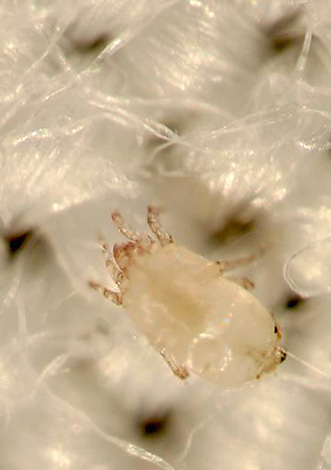
Once in the apartment (for example, being brought with things, dust or furniture), the mites are concentrated mainly in those places where there are most of the particles of peeling skin. As a rule, this space under the beds and sofas. Gradually, they occupy the bed, where the skin of a person appears regularly, although it does not accumulate in large quantities due to the periodic washing of bed linen.
Individuals caught on the bed penetrate inside the pillows and mattresses, where they are practically in greenhouse conditions: a favorable microclimate, complete safety and constantly emerging food (particles of human skin).
Obviously, most often ticks-dermatophages infect pillows, which are:
- They are regularly used for more than a year - a large amount of dust has accumulated in them;
- They have a pillow case and a pillowcase made of cloth with pores of sufficient size;
- Do not brush with the required regularity;
- Located in a room with a microclimate suitable for ticks.
As mentioned above, the type of pillow filler does not play a big role. If the remnants of human skin accumulated in a sinteponovoy or cotton pad, ticks colonize it as actively as the feather.
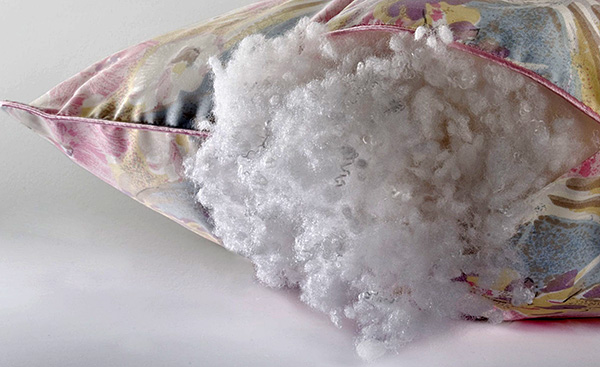
Similarly, we can say what should be the pillow, in which the mites will not be able to settle down and multiply in large quantities:
- Or a pillow-case, or a pillowcase pillow (and preferably both) are made of a material through which neither skin particles nor the mites themselves can penetrate;
- Pillows are regularly washed or dry-cleaned;
- They rarely sleep on the pillow (once in several months), or start to sleep relatively recently (less than a year ago), due to which food for ticks is not present in large quantities;
- The pillow is in a room in which the mites cannot survive - with too low a temperature, or, conversely, lying on a couch, constantly in the sun.
Knowing such criteria of “uncomfortableness” of pillows for dust mites, it is possible to choose quite effective measures to get rid of these unwanted guests and prevent pillows from infecting them.Previously it is useful to make sure that the mites in the pillows have already settled ...
How to find ticks in pillows
The first (albeit not the most reliable) sign of the presence of mites in pillows or other bedding is an allergy, especially one that becomes aggravated in the room, but weakens with a long stay on the street. As a rule, it is she who is the reason for many people to generally learn about the existence of dust mites.
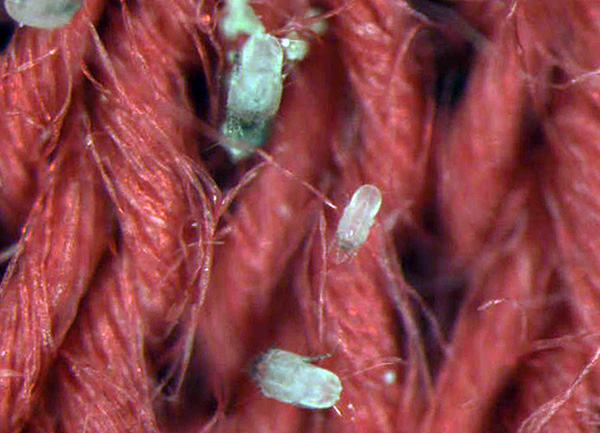
Often a person may suffer from nasal congestion at night for years, until one day he turns to an ENT - he will refer him to an allergist, and already in the clinic, an allergist will diagnose and identify allergies to ticks.
A sign of the presence of ticks in the pillows can be both respiratory allergic diseases and dermatological. If symptoms of such diseases have developed, it is necessary, firstly, to contact a medical institution for diagnosis and treatment, and secondly, to try to find ticks in your home.
How to do it?
The most reliable way is to use special test systems to identify tick-borne allergens.
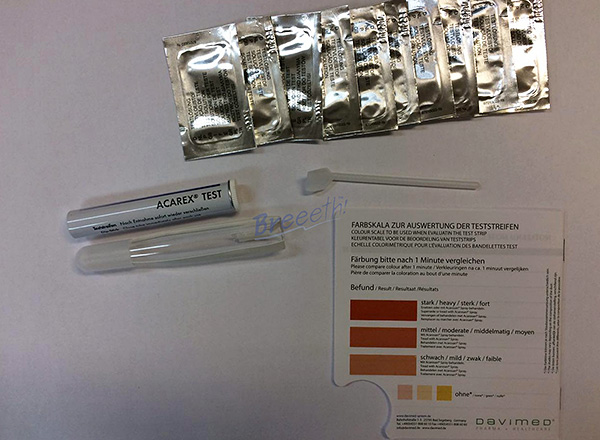
They work very simply:
- The pillow is opened and a small portion of filler is pulled out of it;
- The required amount of water is poured into the test glass, a filler is added;
- A special indicator strip from the test kit is placed in the solution;
- The color of the strip makes a conclusion about the presence and amount of tick-borne antigens in the filler. If these antigens are present, it means that the mites themselves are also present in the pillow (or, at least, were present earlier).
Less than unambiguous result is given by skin tests for allergies in the patient himself. Such a test may show sensitivity to dust mite allergens, but this does not mean that mites live in a pillow. They can be present in any other place in the dwelling and also cause allergies in the person.
On the other hand, if the mites are found in the pillows, then they are more likely to exist in other places of the room. And they will need to be destroyed in the whole apartment.
You can find dust mites in the filler cushion with a microscope. These pests are similar to small insects with a whitish translucent body, quite mobile and crawling tirelessly in the fibers.As a rule, it is the constant movement that attracts attention and allows you to quickly detect them.
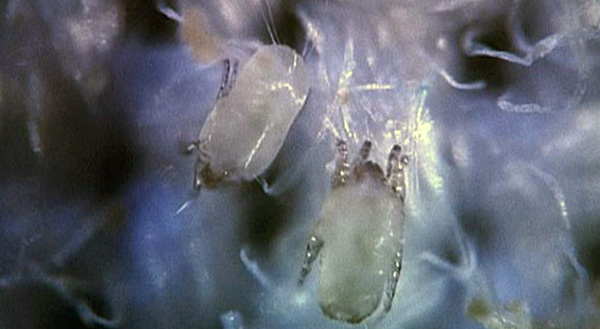
In normal vision, you can try to see dust mites without a microscope, with the naked eye. They look like tiny white dots moving on fabric or in filler. By themselves, they are not striking, but with a targeted search may well be noticeable.
The video below shows dust mites taken under a microscope among the fibers of the fabric:
On a note
If a single dark-colored insect is found in a pillow or on a bed without a microscope at all, this is definitely not a dust mite. This may be a head or pubic louse, a flea, a bed bug, or some other parasite or pest.
Control measures
The most radical methods of removing dust mites from pillows ensure their quick destruction within literally several hours.
These methods include:
- Treatment of pillows using acaricides-based substances - substances that can quickly kill ticks. These include drugs based on organophosphorus compounds, pyrethroids, neonicotinoids and some other substances.When using them, it is necessary to achieve treatment with the preparation of the filler itself, and not just the pillow napernik;
- Freezing pillows in the cold. Although at a negative temperature the mites die within a few hours, you should keep the pillows in the frost for at least 2 days to ensure that the eggs freeze out;
- Heating of pillows in the sun for several hours with an increase in their temperature up to 60-65 ° C, or washing at a water temperature of 60 ° C.

More conservative methods suggest long-term excretion of ticks, but with less risk for pillow material.
In particular, it is advisable:
- Use pillowcases made of cloth that does not allow allergens and dust (permeability for allergens - less than 1%, for dust - less than 4%, pore diameter - not more than 10 microns, air permeability - 2-6 cm3/ (sec * cm2));
- Have two sets of pillows, each of which people sleep no more than 2-3 months in a row.
These measures are good because they do not require much effort and give quick results. In particular, the allergens that are already in the pillow do not go outside and do not enter the human respiratory tract - a pillowcase delays them. The same pillowcase does not allow skin and dandruff to penetrate inside the pillow, and over time, the mites inside it lose their food source.If at the same time no one sleeps on pillows during their rotation for 2-3 months, the ticks are left without food and die out over time.
Very old and heavily infected pillows, in which, moreover, mold has probably started, should be replaced with new ones and thrown out.
Considering that dust mites can live not only in pillows, but also practically in any other places in the room, during their destruction they cannot be confined to the bed. It is necessary to take measures to destroy them at any point in the apartment where dust accumulates.
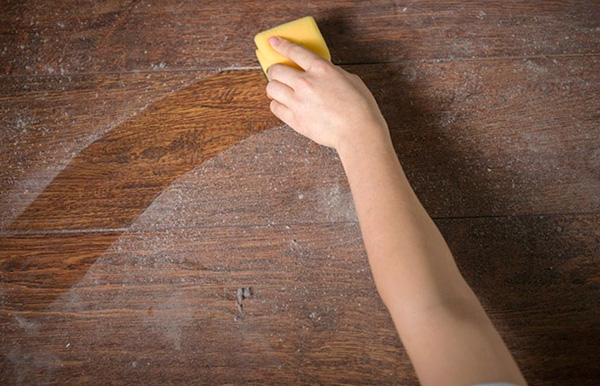
On a note
When dealing with dust mites, it is useful to use special sprays that decompose tick allergens and make them safe for humans. The fact is that even after the complete destruction of ticks, their excrements can remain in the smallest crevices for many months, continuing to cause allergies. If the premises are treated with special degrading sprays, the allergens will no longer be dangerous.
Prevent pillow contamination
Finally, it is easier to prevent ticks from infecting the pillows than to deal with these unwanted guests and, even more so, to cure allergies.
The basis for the prevention of pillow infections is the use of all the same pillowcases impenetrable to ticks, allergens, dust and dandruff. If such pillowcases are put on all the pillows, dust mites simply do not penetrate.
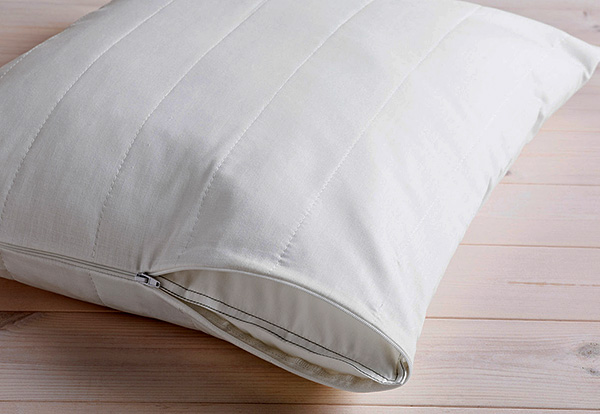
You should also hold other events:
- At least once a week to change and wash bed linen;
- Once a week to carry out a thorough wet cleaning throughout the apartment, removing dust from all places where it can accumulate;
- Ventilate the room regularly, maintain a normal microclimate here.
It is also useful to remove from the apartment the maximum amount of dust accumulators - carpets, carpets, soft children's toys, open shelves with books and open cabinets with things. Here, in the dust, and the largest number of mites accumulates, and it can be extremely difficult to remove them from the same carpets. It is enough to close the shelves with books with glass doors to ensure that no particles of human skin will get here.
Finally, any diseases of the respiratory tract should be diagnosed quickly and in a timely manner, the symptoms of which manifest longer than 7-10 days. Such a duration may already be a sign of allergies and chronicinflammations, and the earlier the cause of the disease is determined, the easier it will be to eliminate this cause. This is important not only for the prevention of tick-borne sensitization, but also for protection against serious diseases in general.
Useful video about the presence of dust mites in the bed
Macro shot of dust mites swarming on pillow fabric

